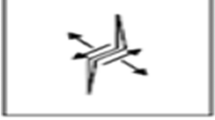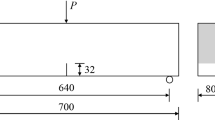Abstract
The direct and indirect methods of examining microcracks are reviewed. It is concluded that the discontinuity stress is a fundamental property of concrete. It signifies (1) the end of the quasi-elastic behavior of concrete (2) the long time sustained strength of concrete, (3) the point at which the Poisson's ratio starts to increase, and (4) the point at which mortar cracks begin to develop extensively. However, a logical and measurable definition of discontinuity stress has not yet been found. This paper suggests a new approach to define discontinuity stress based on fatigue tests. The fatigue interactions surface is derived, which reveals a measurable “kink”. This “kink” represents the discontinuity stress. Below this “kink” in the high cycle region, microcracks are developing as bond cracks in a slow gradual process. Above the “kink” in the low cycle region, mortar cracks are forming continuous networks.
Résumé
On revoit les méthodes directes et indirectes d'examen des microfissures. On en conclut que la discontinuité des contraintes est une propriété fondamentale du béton. Cela implique (1) la fin du comportement quasi-élastique du béton; (2) la résistance à long terme du béton; (3) le point auquel le coefficient de Poisson commence à croître; (4) le point auquel les fissures du mortier commencent à se propager largement. On n'a cependant pas encore trouvé une définition logique et quantifiable de la discontinuité de contrainte. On suggère ici une nouvelle approche pour définir la discontinuité de contrainte d'après les essais de fatigue. On déduit la surface d'interaction de fatigue qui laisse voir une «singularité» mesurable. Cette «singularité» représente la discontinuité de contrainte. En deçà de cette «singularité», dans la zone des grands nombres de cycles, les microfissures se propagent en tant que fissures d'adhérence selon un processus lent et graduel. Au-delà de la «singularité» dans la zone oligo-cyclique les fissures du mortier forment des réseaux continus.
Similar content being viewed by others
References
Richart F. E., Brantzaeg A., Brown R. L.—A study of the failure of concrete under combined compressive stresses, Bulletin No. 185, Univ. of Illinois Engineering Experimental Station, Urbana, Illinois, November 1928.
Richart F. E., Brantzaeg A., Brown R. L.—The failure of plain and spirally reinforced concrete in compression, Bulletin No., 1980, Univ. of Illinois Engineering Experimental Station, Urbana, Illinois, April 1929.
Jones R.—A method of studying the formation of cracks in a material subjected to stresses, British Journal of Applied Physics (London), Vol. 3, No. 7, July 1952, pp. 229–232.
L'Hermite R.—Present day ideas on concrete technology, 3rd Part, The failure of concrete, Bulletin No. 18, Union of Testing and Research Laboratories for Materials and Structures (RILEM), June 1954, pp. 27–39.
Rusch H.—Physikalische Fragen der Betonprüfung, Zement-Kalk-Gips, Vol. 12, No. 1, 1959, pp. 1–9.
Sell R.—Investigation into the strength of concrete under sustained loads, Bulletin No. 5, Union of Testing and Research Laboratories for Materials and Structures (RILEM), Sec. 1959, pp. 5–13.
Hsu T. T. C., Slate F. O., Sturman G. M., Winter G. —Microcraking of plain concrete and the shape of the stress-strain curve, Journal of the American Concrete Institute, Proc., Vol. 60, No. 2, Feb. 1963, pp. 209–224.
Slate F. O., Olsefski S.—X-Rays for study of internal structure and microcracking of concrete, Journal of the American Concrete Institute, Proc., Vol. 60, No. 5, May 1963, pp. 575–588.
Hsu T. T. C.—Mathematical analysis of shrinkage stresses in a model of hardened concrete, Journal of the American Concrete Istitute, Proc., Vol. 60, No. 3, March 1963, pp. 371–390.
Hsu T. T. C., Slate F. O.—Tensile bond strength between aggregate and cement paste or mortar, Journal of the Americal Concrete Institute, Proc., Vol. 60, No. 4, April 1963, pp. 465–486.
Newman K.—Criteria for the behavior of plain concrete under complex state of stress, Proc. International Conference on the Structure of Concrete (London, September 1965), Brooks, A. E., Newman K., Ed., Cement and Concrete Association, London, 1968.
Jones R.—Cracking and failure, of concrete test specimens under uniaxial quasi-static loading, Proc., International Conference on the Structure of Concrete, Cement and Concrete Association, London, 1968, pp. 125–130.
Robinson G. S.—Behavior of concrete in biaxial compression, Journal of the Structural Division, ASCE, Proc., Vol. 93, No. ST1, February 1967, pp. 71–86.
Vile G. W. D.—The strength of concrete under shortterm static biaxial stress, Proc., International Conference of the Structure of concrete, Cement and Concrete Association, London, 1968, pp. 131–145.
Buyukozturk O., Nilson A. H., Slate F. O.—Stress-strain response and fracture of a model of concrete in biaxial loading, Journal of the American Concrete Institute, Proc., Vol. 68, No. 8, August 1971, pp. 590–599.
Liu T.C. Y., Nilson A. H., Slate F. O.—Stress-strain response and fracture of concrete in unixial and biaxial compression, Journal of the American Concrete Institute, Proc., Vol. 69, No. 5, May 1972, pp. 291–295.
Carino N. J., Slate F. O.—Limiting strain criterion for failure of concrete, Journal of the American Concrete Institute, Proc., Vol.73, No. 3, March 1976, pp. 160–165.
Tasuji M. E., Slate F. O., Nilson A. H.—Stress-strain response and fracture of concrete in biaxial loading, Journal of the American Concrete Institute, Proc., Vol. 75, No. 7, July 1978, pp. 306–312.
Shah S. P., Chandra S.—Critical stress, volume change and microcracking of concrete, Journal of the American Concrete Institute, Proc., Vol. 65, No. 9, September 1968, pp. 770–781.
Aas-Jakobsen K.—Fatigue of concrete beams and collumns, Bulletin No. 70-1, NTH Institute for Betonkonstruksjoner, Trondheim, September 1970.
Tepfers R., Kutti T.—Fatigue strength of plain, ordinary and lightweight concrete, Journal of the American Concrete Institute, Proc., Vol. 76, No. 5, May 1979, pp. 635–652.
Tepfers R.—Tensile fatigue strength of plain concrete, Journal of the American Concrete, Institute, Proc., Vol. 76 No. 8, August 1979, pp. 919–933.
Hsu T. T. C.—Fatigue of plain concrete, Journal of the American Concrete Institute, Proc., Vol. 78, No. 4, July–August, 1981, pp. 292–305.
Rusch H.—Researches toward a general flexural theory for structural concrete, Journal of the American Concrete Institute, Proc., Vol. 57, No. 1, July 1960, pp. 1–28.
McHenry D., Shideler J. J.—Review of data on effect of speed in mechanical testing of concrete, ASTM Special Technical Publication No. 185, 1956, pp. 72–82; Also PCA Research and Development Laboratory Bulletin D 9, 1956.
Galloway J. W., Raithby K. D.—Effect of rate of loading on flexural strength and fatigue performance of concrete, Transport and Road Research Laboratory, Report LR 547, Dept. of Environment, Crowthrone, England, 1973.
Author information
Authors and Affiliations
Rights and permissions
About this article
Cite this article
Hsu, T.T.C. Fatigue and microcracking of concrete. Mat. Constr. 17, 51–54 (1984). https://doi.org/10.1007/BF02474056
Issue Date:
DOI: https://doi.org/10.1007/BF02474056




